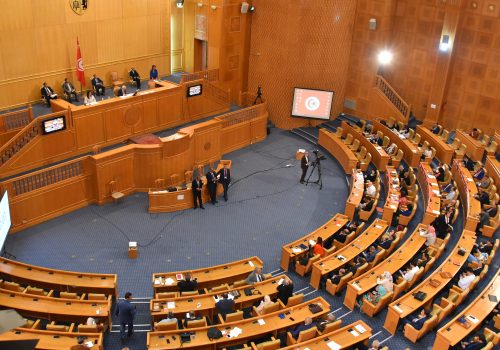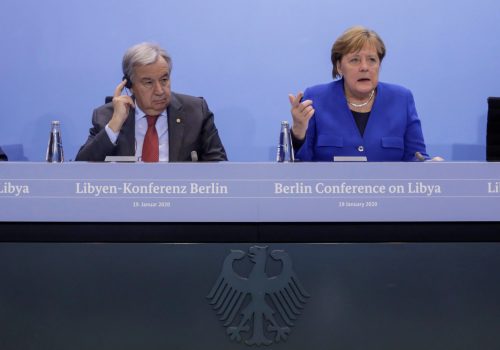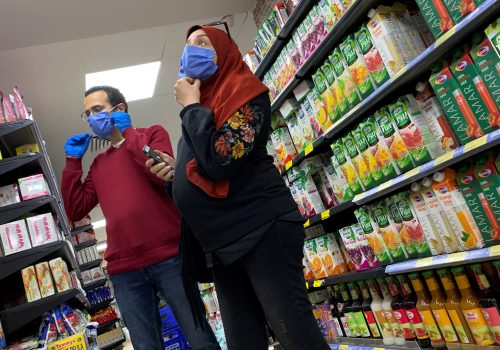Protests in Tunisia conjure images of the past and questions about the future
On Habib Bourguiba Boulevard, demonstrations call for “the fall of the regime.” At night, police clash with protesters in clouds of tear gas. Hundreds of demonstrators—many who have yet to celebrate their eighteenth birthday—are arrested and thrown in jail. This isn’t Tunisia in January 2011. This is Tunisia in January 2021.
The tenth anniversary of Tunisia’s revolution should have been a time for celebration. Instead, it has been a period of increasing alarm as near-daily protests spread across the country from mid to late January, and some demonstrations continuing in February. A twisted déjà vu in which Tunisia’s youth have returned to the streets to make known their discontent with a government they helped establish a decade ago by overthrowing a dictator.
These protests are important, not just because of what they tell us about Tunisia’s current political climate, but because they serve as a litmus test for Tunisia’s approach to democracy building. The Tunisian approach has prioritized political consensus, reasoning that it would maintain stability while still creating the requisite political and economic change to improve citizens’ socio-economic conditions. However, as these protests make clear, there are serious questions about whether that deference has gone too far, creating too little change and, now, undermining stability.
Delivering democracy without change
As an ever-increasing number of newspaper articles, blogs, and reports have noted, the last decade successfully delivered Tunisian democracy, but it is increasingly apparent that democracy has not delivered for many Tunisians. The rallying cry in late 2010 and early 2011 was “work, freedom, and national dignity”—the push for democracy was a means towards those ends, not for democracy as an end in-and-of-itself. Ten years after the revolution, nearly nine in ten Tunisians think the country is headed in the wrong direction and the majority of the country is unconvinced that democracy is the best form of government. Those numbers are worrisome, but somewhat expected; Tunisia’s economy now grows at about half the rate it did before the revolution, inflation has roughly doubled over the same period, and unemployment has gone up.
The ramifications of not delivering on the revolution’s rallying cry has been felt throughout Tunisia’s political system for some time. This is most obvious in the recent prevalence of populist politicians: the rise in profile of a counterrevolutionary politician Abir Moussi in 2020; the 2019 presidential election of Kais Saied; and Saied’s electoral opponent, media mogul Nabil Karoui. But it is also apparent in the uptick of Tunisians leaving for Italy and the large protests in response to tax hikes in 2018.
As a recent Institute for Security Studies report notes, “The goals and promise of the Freedom and Dignity Revolution remain unfulfilled for Tunisians. It is increasingly clear that regular elections will not translate into better opportunities without deep and structural economic reforms. The coronavirus downturn has exacerbated an already precarious situation.”
Taking a cue from the Institute for Security Studies, it is important to position the action in the streets of Tunisia within the broader context of reforms. Doing so illuminates tendencies within the country’s approach to democracy building and raises questions about its stability moving forward. Specifically, these protests create a dichotomy between the state and the citizenry, in the form of police and protestor, which helps illustrate the complexity of Tunisia’s current political situation.
Security forces haven’t changed their ways
Police brutality was a very compelling mobilizer during Tunisia’s revolution. Mohamed Bouazizi’s act of self-immolation, which launched Tunisia’s revolution, came after police harassed him about being a street vendor. Bouazizi’s martyrdom resonated powerfully across the country because his story coalesced Tunisia’s broader issues of state oppression and economic disparity into a simple narrative. The hopelessness and frustration that Bouazizi clearly felt were deeply familiar to other Tunisians.
In the protests that occurred after Bouazizi’s immolation, clashes between protests and internal security forces were common. As protests spread across the country and intensified in January 2011, police reform became an important revolution objective. However, while some important initial steps were taken in the first months following the revolution to overhaul security forces, true reform never happened.
Tunisian politicians avoided reforming the security sector in large part because of the myriad of security threats that Tunisia has faced over the past decade: the 2012 attack on the United States Embassy in Tunisia, the civil war in neighboring Libya, multiple largescale terror attacks in 2015, the high number of Tunisian citizens who left to fight for the Islamic State of Iraq and al-Sham (ISIS), and the continued existence of Islamic extremists in the mountains bordering Algeria.
But the lack of reformative action also indicates the importance Tunisia’s elected officials have given to maintaining stability through consensus at the expense of pursuing the revolution’s mandate. This logic is the defining characteristic of Tunisia’s post-revolutionary politics and its mettle is currently being tested in the streets.
With each story of arbitrary detention, arrest of minors by police barging into their homes, or harassment of journalists for filming an arrest, it seems obvious that the security forces are operating much as they did under ousted dictator Zine El Abidine Ben Ali. Close observers of Tunisia are not surprised that the police have kept up a number of their pre-revolution tactics, including arbitrary restrictions on movement and torture.
What direction does Tunisia go?
This casts a shadow over Tunisia’s entire project in democracy building. The institutions that were oppressive instruments of the old regime need to change for Tunisia to achieve “work, freedom, and national dignity.” Like the timid approach to security sector reformation, deep economic reforms and transitional justice mechanisms have been avoided or defanged throughout the past ten years, as politicians sought to avoid political confrontation that could upset consensus across major political parties.
The argument for this approach is that gradual change produces a more stable long-term trend of democratic consolidation. It has been a decade since Tunisian security forces were in the streets limiting Tunisians’ freedom and violating their dignity in the name of an autocrat. If the political system is the independent variable—switched from autocracy to democracy—then the structure and membership of security forces are the control variable and police repression is the dependent variable. This means that the presence of a democratic election alone has not made much of a difference.
Tunisia’s politics of consensus has spent most of the past ten years being lauded—a grand political coalition that has delivered dialogue instead of destruction. Broadly speaking, that is true. Tunisia’s was the only Arab Spring revolution to produce a democracy. The country also has avoided a major counterrevolution and there have been repeated peaceful transitions of power over the last decade. However, a growing contingency of experts wonder if the obeisance to consensus has gone too far, creating fissures in the foundation of Tunisia’s democracy. As a recent report from Sharan Grewal and Shadi Hamid at the Brookings Institute posit, “the extended pursuit of consensus in Tunisia,” from 2015-19, “has also had a dark side, constraining its democratic transition.”
The past few weeks make this argument seem prescient. It will likely continue to seem that way throughout the remainder of the year. Even if the demonstrations cease in the short term, the underlying political and economic issues will not, nor will the added socioeconomic stress of the COVID-19 pandemic in the medium term. These broader trends are being compounded by the resemblance between the tableaus of early 2021 and January 2011. That does not mean that Tunisia is on the verge of collapse—revolutions are rare and hard to predict—but it is a worrying step in the wrong direction.
Keith Jones is assistant director of corporate relations at the Atlantic Council. He previously conducted research in Tunisia on youth organizations, active citizenship, and democratic consolidation.
Image: A female young protester raises a placard that reads in Arabic, 'there is an armoured vehicle between the representative of the people and the People', as another raises a placard that reads, 'No justice, no peace, fall of the police state' as they stand in front of security forces members forming a wall to prevent their comrades (not shown) from demonstrating in front of the building of the Tunisian Parliament in Bardo. Dozens of young people from the tough neighborhood of Hay Ettadhamen took to the streets in an anti-government protest march that started from their neighborhood and headed towards Bardo city in Tunis. The demonstrators have demanded the release of youths arrested by the police during the latest nightly protests, and denounced the police violence and the repression of the social protest movements. Tunisia, January 26, 2021.


